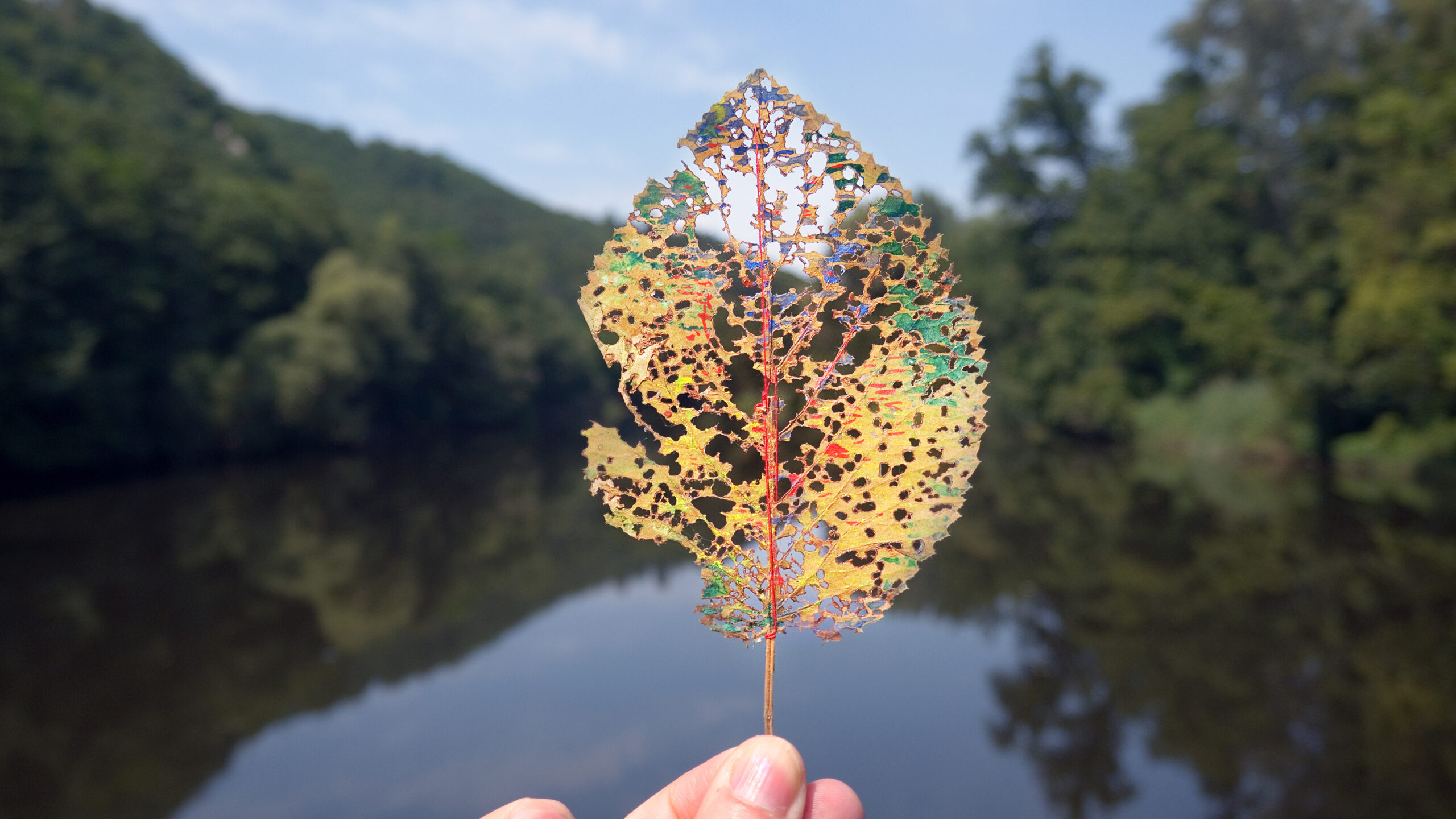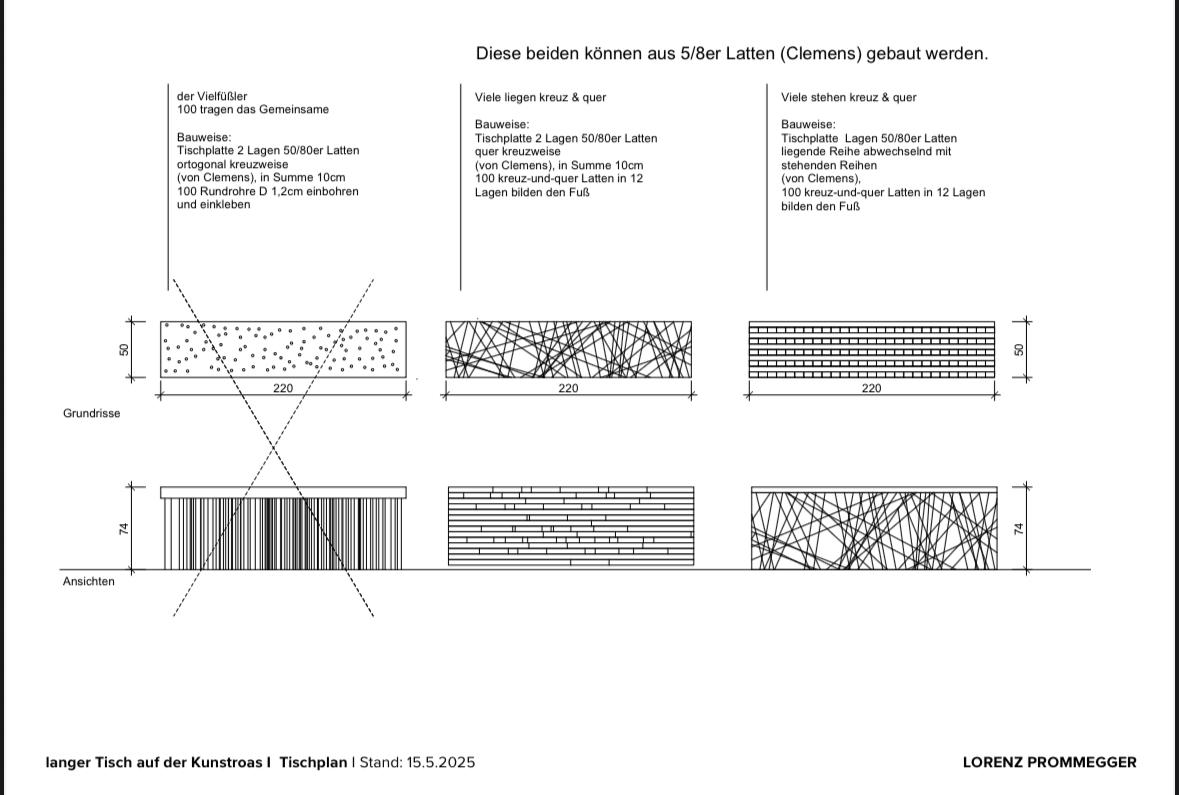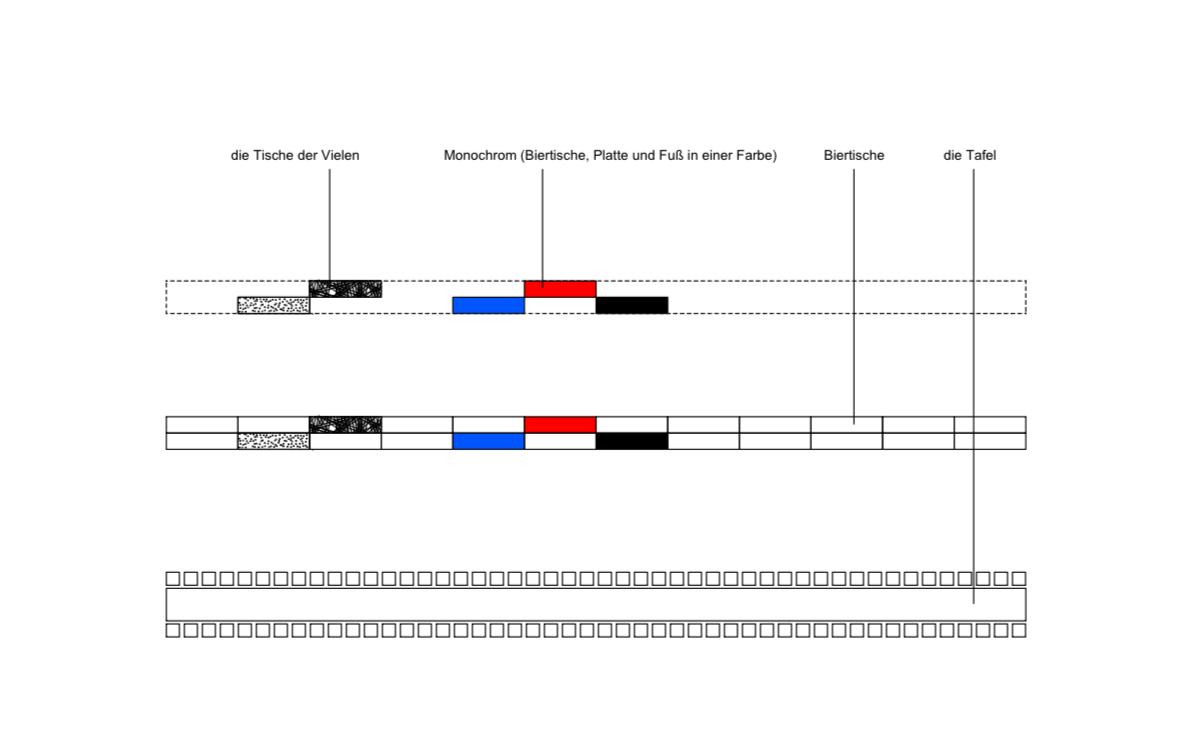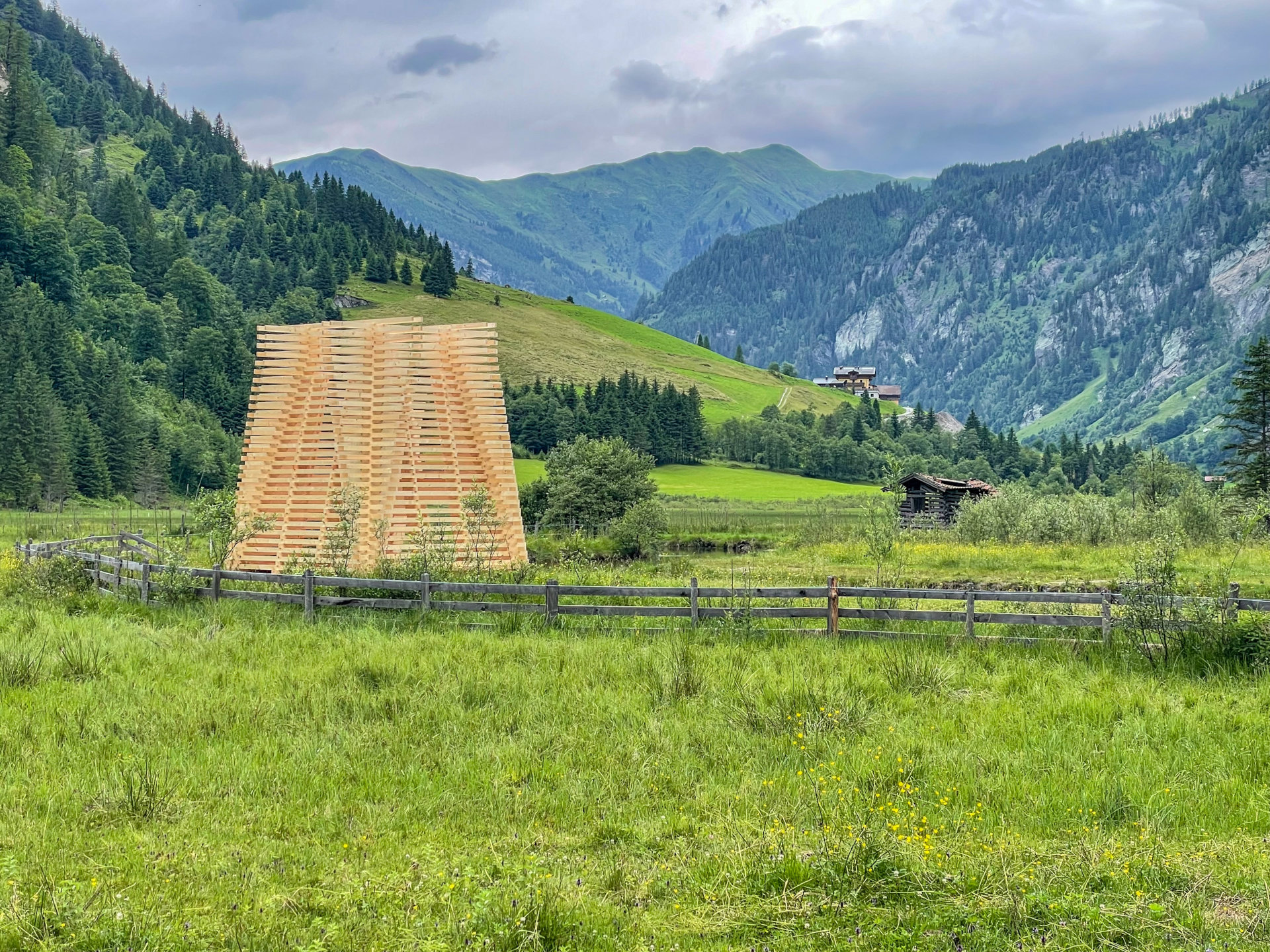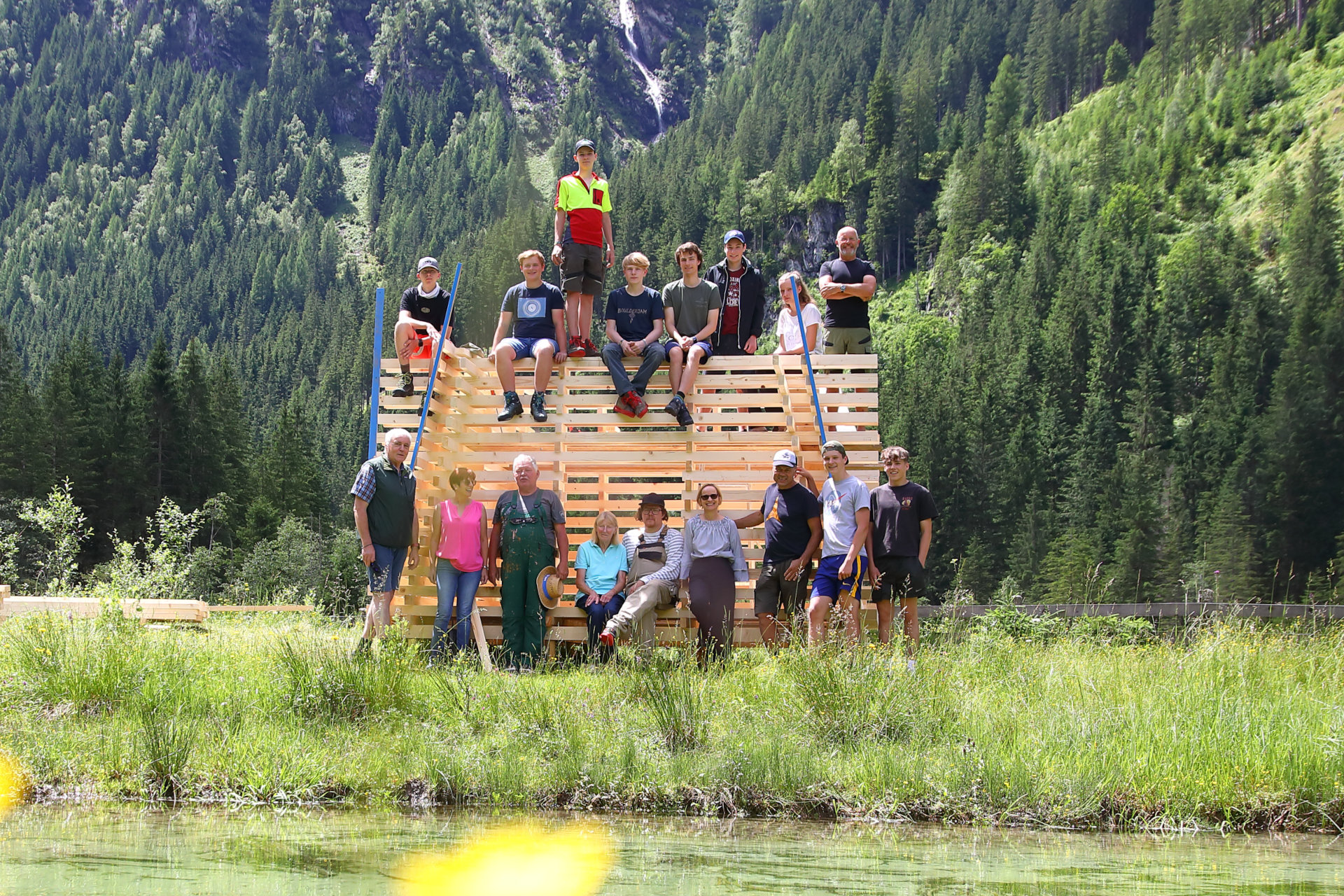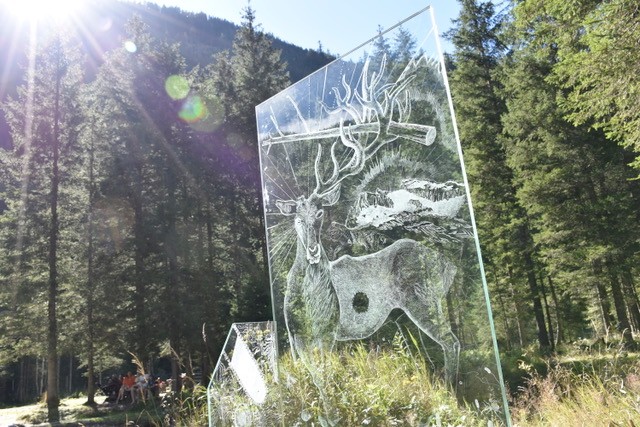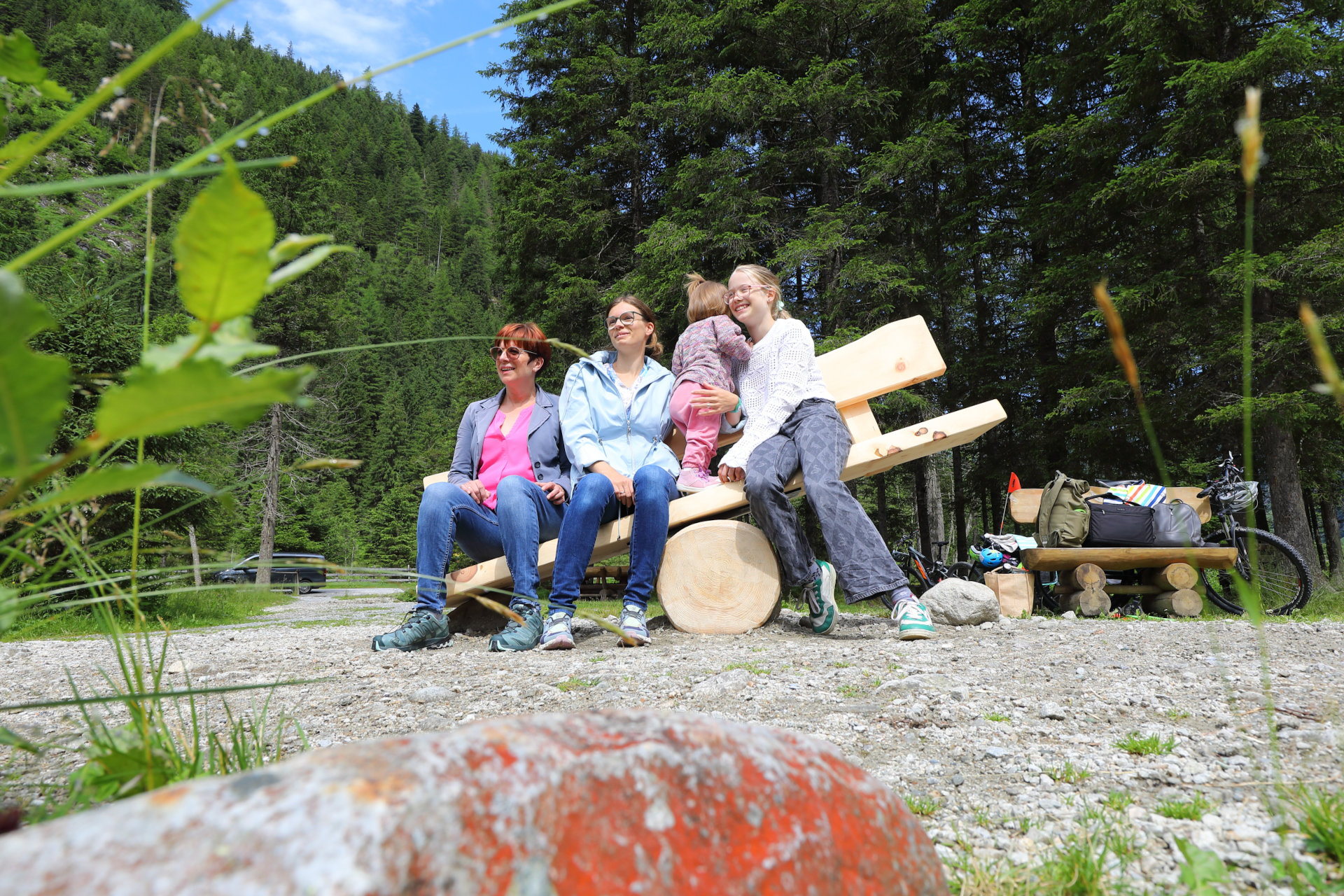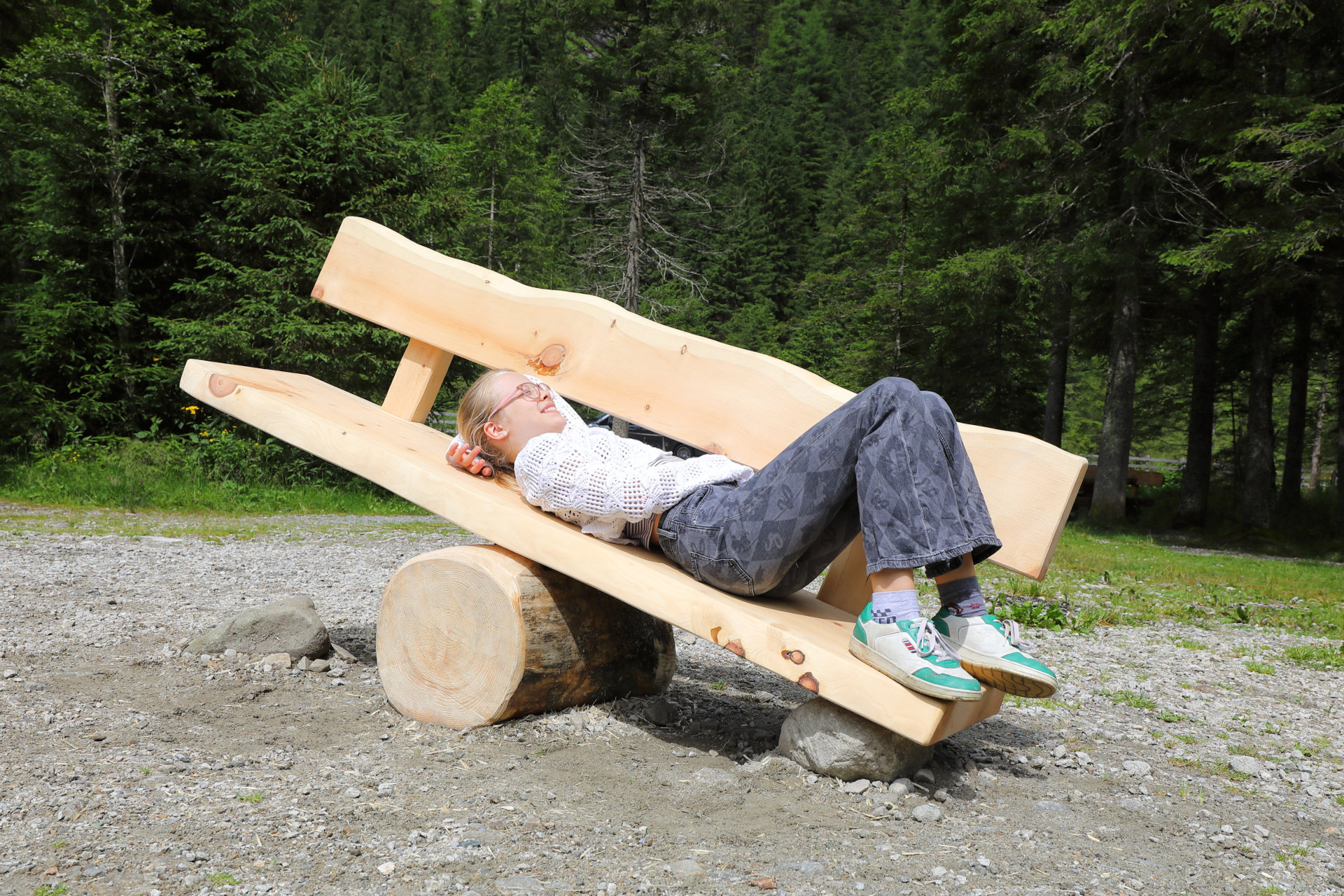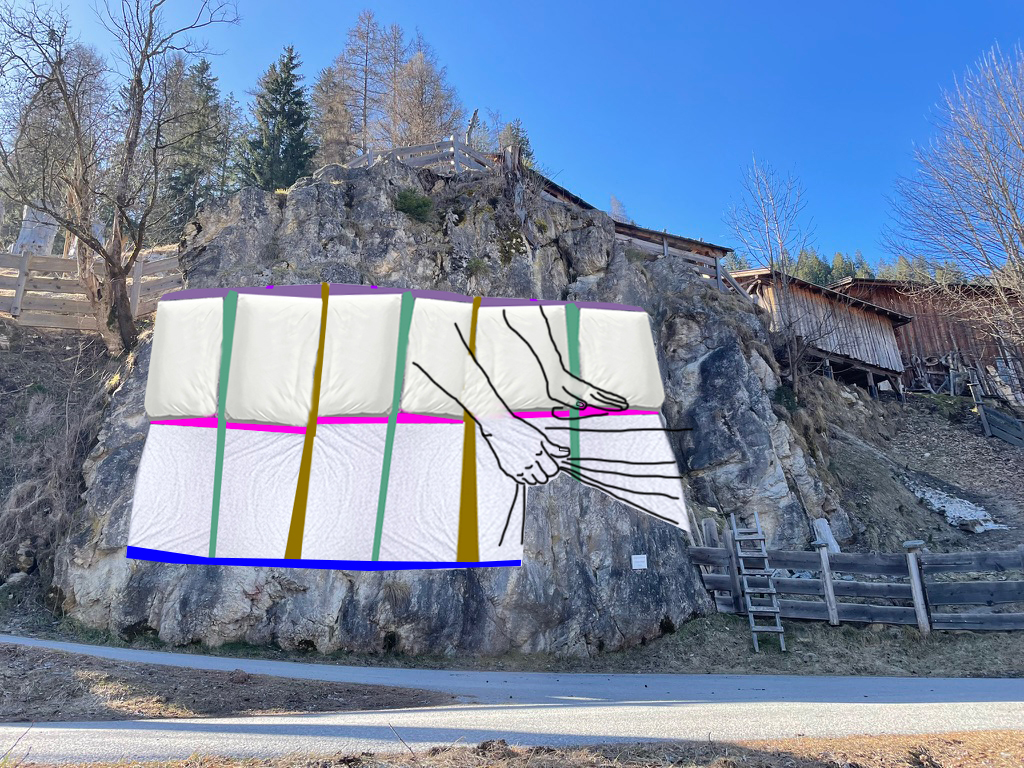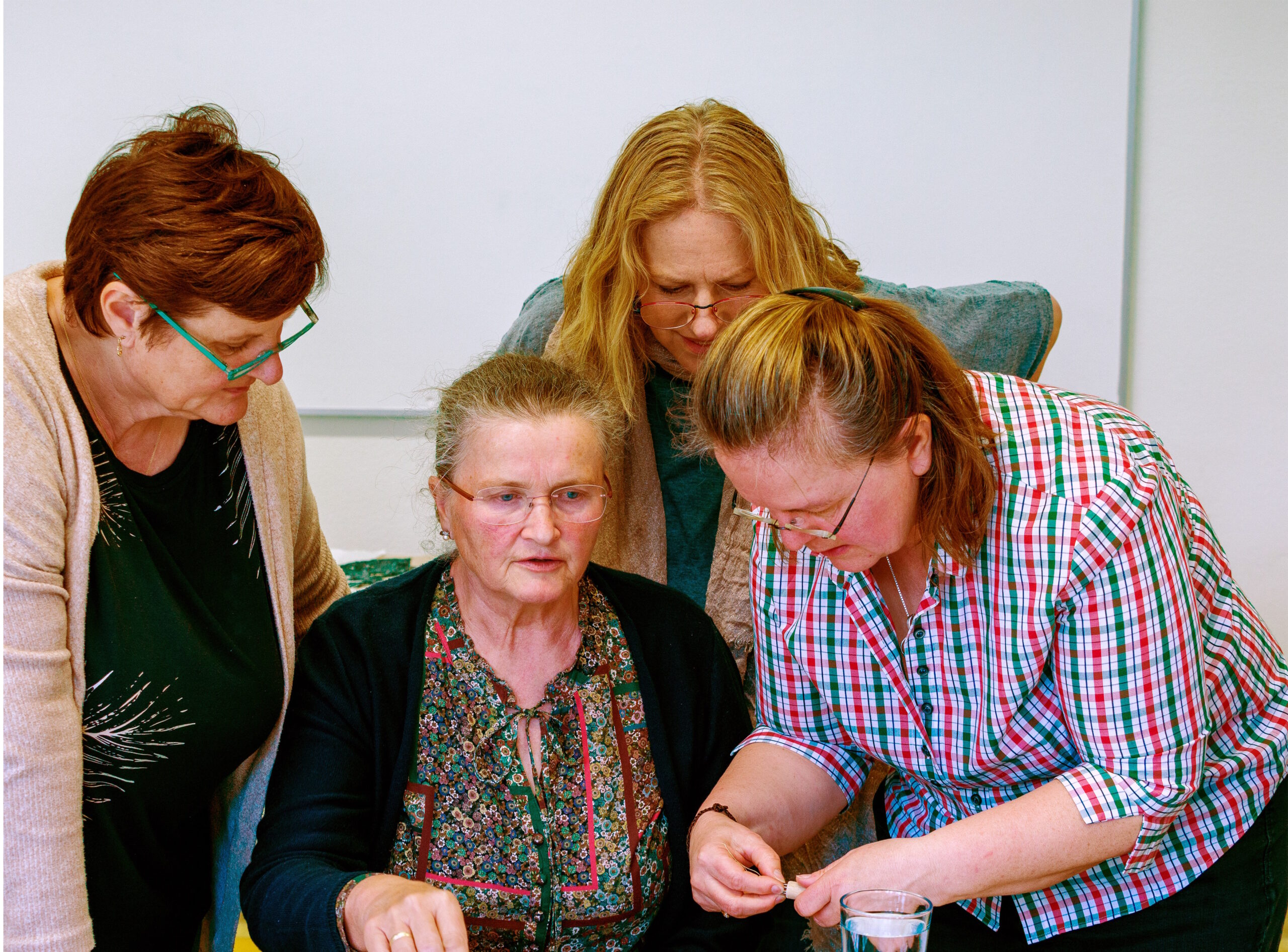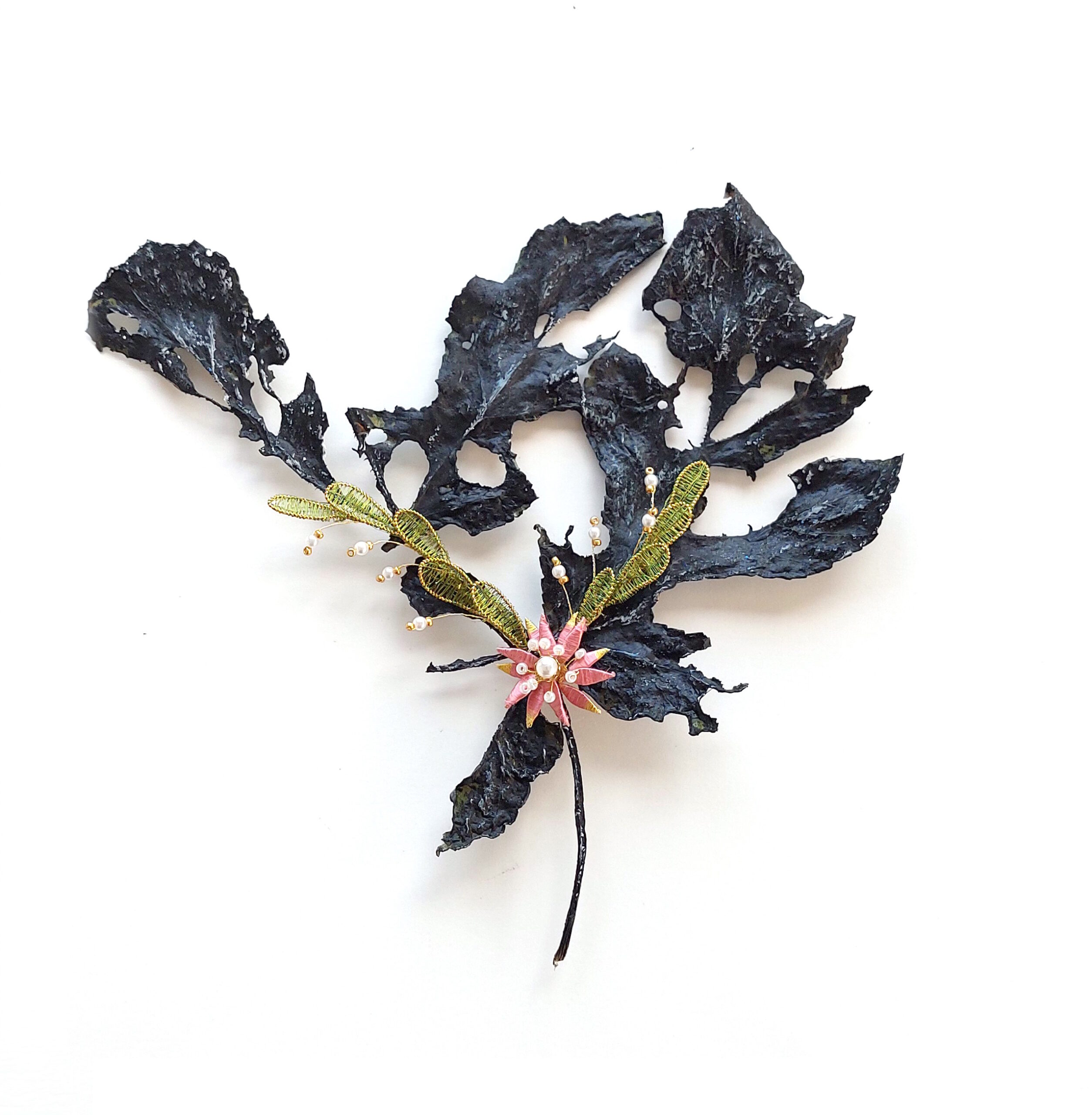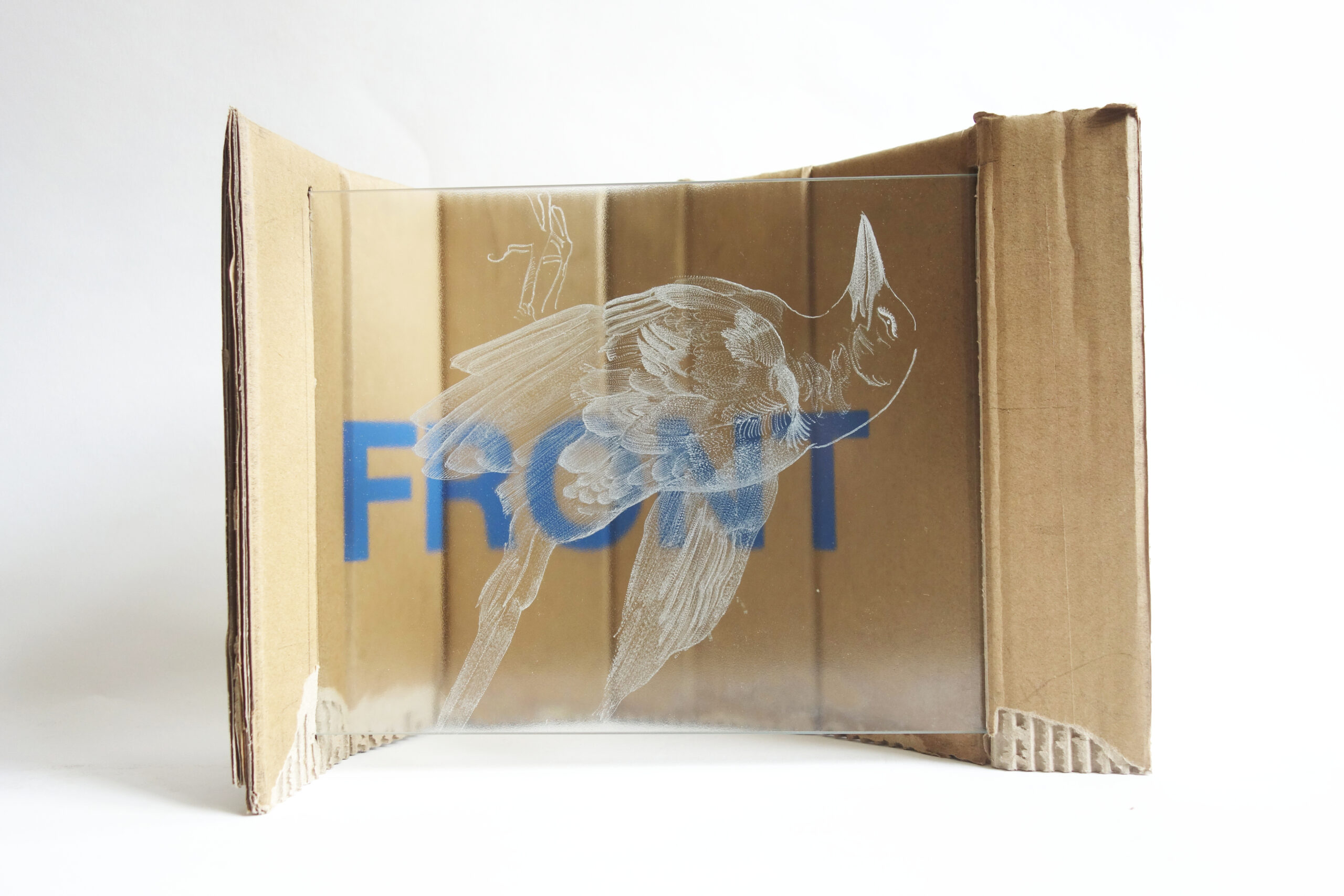About living well together
Gallery of Travelling Leaves
ANGELA ANDORRER
Andorrer collects unusual, often damaged leaves from nature, dries them and preserves their fragile beauty and preserves their fragile beauty. Using acrylic, oil, ink, yarn and beads, she makes fine markings that give the leaves a new identity. These ‘leavescapes’ accompany her on hikes, where the artist exposes them to the weather, sun, snow and wind in a wide variety of landscapes and portrays them in a new light.
A double relocalisation will take place for kunstroas 2025: 12 motifs will be printed on flag fabric and installed in the landscape of the Grossarl Valley. In this field of tension between protection and transience, questions of being in nature and mindfulness in dealing with it are negotiated.
Gallery of Travelling Leaves © Angela Andorrer
Long Table. Everyday architecture as a social stage
LORENZ PROMMEGGER, X ARCHITEKTEN
The Long Table © Lorenz Prommegger
The table takes centre stage – not just as furniture, but as a symbol of coming together. Two movements: Stretching and gathering. The long table requires a spatial extension – the more people come together, the longer it has to be. This architectural gesture of ‘stretching’ creates space for encounters and signals openness. A table for everyone – and more than that.
The table becomes a play area, a stage for summer life. From board game tournaments to citizens’ councils to spontaneous conversations – it belongs to everyone. ‘Table game’ also means that the tables themselves become players. Black, blue, red – each table embodies an idea. The ‘table of many’ slats symbolises togetherness and cohesion in the valley. The big transformation: On 13 July, all the tables – from the distinctive ones to the simple beer tables – come together to form one big table. The white tablecloth unites them symbolically: many become one. Diversity becomes community.
Hay barn variation reloaded
CLEMENS BAUDER; realisation with KARL ENTACHER & pupils of the HTL Kuchl
Hay barn variation reloaded © Clemens Bauder
As in many mountain regions, small hay barns are also closely linked to the landscape in the Grossarl Valley. For the kunstroas, Bauder developed an ensemble of micro-architectures in Hüttschlag back in 2023, which take up the traditional building form of log buildings and reinterpret them. Now a hay barn variation is being rebuilt on the Fischbacher meadow.
‘Many hay barns are losing their original purpose and are increasingly falling into disrepair – even in the Grossarl Valley. Their interpretation is intended to draw attention to the fact that they should be preserved and maintained as beautiful micro-architecture in the landscape. Perhaps they could also be reused or repurposed,’ says Bauder.
Eye glasses Lights
INGRID SCHREYER
Eye glasses Lights © Ingrid Schreyer
The legend of St Hubert is reinterpreted in this large-format glass engraving: St Hubert, who, in the midst of hunting fever and faced with the sudden appearance of a white stag – with a cross in its antlers – abandons his plan and converts, paradoxically becomes the patron saint of hunters instead of game.
A colourless and disembodied stag stands opposite us like a fairy tale. Equipped with only one set of antlers, but armed with a forest stick, he eyes us critically. The question arises: who enlivens, who desires, who dishonours, who exalts the Alpine region? Good coexistence with nature requires a view at eye level, the recognition of animal perspectives too. Only with this mindfulness can we really understand – not just observe.
In balance
HERI & SALLI
In balance © TVB Großarltal
Walking benches invite you to come to rest, enjoy the view or take a break – they encourage passivity and invite you to daydream. The bench from heri & salli, on the other hand, demands activity: it looks familiar, but works like a seesaw. Anyone taking a seat has to keep their balance and engage in movement. The bench becomes a symbol for living together: It requires mindfulness, consideration and the willingness to constantly find a new balance – with oneself and with others.
Full load – transparent
MARLENE HAUSEGGER
Full load © Marlene Hausegger
The artist transforms discarded sheets from the valley’s hotels into a multi-layered, expressive work of art. These fabrics, which once recorded the footsteps of countless guests, become a new image of their surroundings. The valley, where almost 40 nationalities work in tourism, is characterised by movement, encounters and invisible work – especially that of women. The work – the daily bed-making, the smoothing of the sheets – often goes unnoticed.
By sewing the old sheets together with coloured stripes, the artist creates a narrative fabric of memory. Hands that carefully stroke the fabric give form to gestures that would otherwise remain invisible. Installed at the Breitteiweg-Palfen, the work rises up as a visible sign of recognition – a textile manifesto for all those whose work often goes unnoticed.
Berg-Schule Großarl
Reliquie Natur 02
ANGELA ANDORRER, WERKGRUPPE KLOSTERARBEITEN & WOMEN OF THE GROSSARLTAL
Reliquie Natur 02 is a participatory project that combines historical, textile monastery work techniques with contemporary art practice. In collaboration with Brigit Aigner from the Werkgruppe Klosterarbeiten and local actors from Grossarltal, Andorrer initiates a collective work process that interweaves artistic and cultural practices.
The leaf functions as a central symbol of transience and vitality – at the same time as a secularised relic that reflects nature as a worthy, revered object. The textile discourse space thematises female culture of remembrance and social transmission through handicraft. The resulting works and their documentation are presented as a social resonance space in the Berg-Schule Großarl.
Reliquie Natur 02 © Angela Andorrer
Silent Seasons #Diorama
INGRID SCHREYER
In this work, Schreyer creates a fragile archive of disappearance. She frames glass engravings of endangered species in display cases made of corrugated cardboard – relics of global flows of goods. The glass does not protect, it shows: carved outlines between presence and dissolution. Schreyer deals with questions of ecological guilt in the Anthropocene – an era in which preservation seems impossible.
The choice of materials – cardboard and glass – becomes a metaphor for instability. The Batagaika crater, a symbol of geological erosion and climate crisis, refers to irreversible processes. These dioramas look downwards, into layers of time and responsibility. The result is an art of securing traces – a pause in the face of disappearance.
Silent Seasons #Diorama © Ingrid Schreyer
